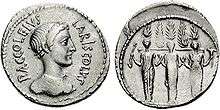Accoleia gens

The gens Accoleia, also spelled Acculeia, Acoleia, or Aculeia was a minor plebeian family at Rome during the first century BC. Most of what is known of the family comes from various coins and inscriptions.[1]
Origin and meaning
The origin of the nomen is obscure, but the gens apparently shared its name with one of the thirty curiae, or wards, which formed divisions of the three Romulean tribes, suggesting that the family might have been of great antiquity, although if so it was exceedingly obscure. One tradition states that the curiae were named after the Sabine women carried off in the time of Romulus. Of the few whose names are known, several correspond with particular neighborhoods of Rome, although this does not establish whether the wards were originally named after historical or mythological personages.[2]
One such person, Acca Larentia, was the foster-mother of Romulus and Remus, suggesting that perhaps Acculeia was a nomen derived from Acca. This might account for the fact that the curia Acculeia carried out a sacrifice in honor of Angerona, the tutelary goddess of Rome itself, during the Angeronalia.[3] A denarius issued by Publius Accoleius Lariscolus, pictured above, may represent the worship of Acca Larentia, although the figure has also been identified as that of Diana Nemorensis, depicted as a triple goddess.[2]
Perhaps less romantically, the nomen could be derived from the noun aculeus, meaning a thorn or needle, or the corresponding adjective, with the additional meaning of sharp.[4][5]
Praenomina
The only praenomina known to have been used by the gens are Publius, Lucius, and Marcus.[6]
Branches and cognomina
Three cognomina are known to have been used by members of this family: Lariscolus, Euhermerus, and Abascantus. Since the gens does not seem to have been very large, these were probably personal, rather than hereditary surnames.[7]
Members
- This list includes abbreviated praenomina. For an explanation of this practice, see filiation.
- Publius Accoleius Lariscolus, triumvir monetalis in 43 BC.
- Publius Accoleius Euhemerus, from an inscription.[8]
- Lucius Accoleius Abascantus, from an inscription.[9]
- Marcus Accoleius M. f., from an inscription.[10]
- Aculeia Bachis, from an inscription.[11]
See also
References
- ↑ Dictionary of Greek and Roman Biography and Mythology, William Smith, Editor
- 1 2 Harper's Dictionary of Classical Literature and Antiquities, Second Edition, Harry Thurston Peck, Editor (1897)
- ↑ Marcus Terentius Varro, De Lingua Latina libri XXV.
- ↑ John C. Traupman, The New College Latin & English Dictionary (Bantam, 1995).
- ↑ D.P. Simpson, Cassell's Latin & English Dictionary (1963).
- ↑ Dictionary of Greek and Roman Biography and Mythology, William Smith, Editor
- ↑ Dictionary of Greek and Roman Biography and Mythology, William Smith, Editor
- ↑ CIL XIV, 246
- ↑ CIL VI, 200
- ↑ Corpus Inscriptionum Latinarum i. 1433.
- ↑ Corpus Inscriptionum Latinarum ii. 589.
![]() This article incorporates text from a publication now in the public domain: Smith, William, ed. (1870). "article name needed". Dictionary of Greek and Roman Biography and Mythology.
This article incorporates text from a publication now in the public domain: Smith, William, ed. (1870). "article name needed". Dictionary of Greek and Roman Biography and Mythology.
Bibliography
- Giulia D'Angelo - Alberto Martín Esquivel, P. Accoleius Lariscolus (RRC 486/1) in Annali dell'Istituto Italiano di Numismatica, 58 (2012), pp. 139-160;